Barkstall STEM Night Exposes Students and Their Families to Fun Science and Engineering
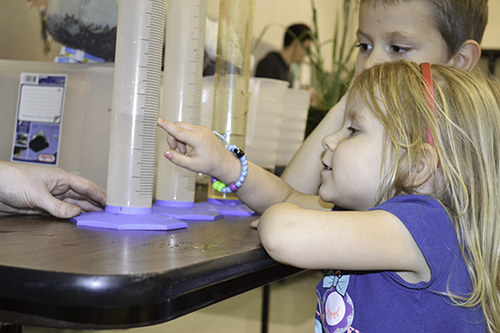
A young visitor to Barkstall STEM Night engaged during a demonstration about erosion by Danielle Cooney, an Illinois Crop Sciences graduate student.
March 15, 2017
A large number of Barkstall Elementary School students, along with their parents and siblings, ended up back at school on Thursday evening, February 23rd to take part in the school’s STEM Night. In addition to viewing science fair project posters made by Barkstall students, participants took part in a number of fun, STEM-related hands-on activities and demonstrations presented by Barkstall folks, as well as University of Illinois students, including some from the Physics Van and REACT outreach groups.
According to the Barkstall Principal, Peter Foertsch, the school tries to do academic nights to get families involved by coming out to participate in a variety of activities. He reports that in the past, they’ve done a reading night, and writing night as well, but that this particular night’s activities were an extension of students' enrichment activities:
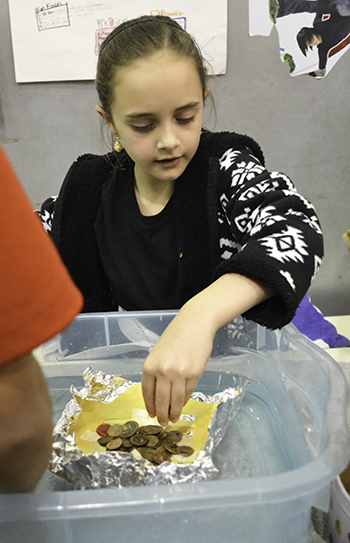
A Barkstall student tests the "boat" she built to see how many pennies it will hold.
“And this night is for our STEM night, which encompasses science, math, and some engineering things that our fifth graders are working on, and our other kids in enrichment are working on as well. We can extend that through this fun night tonight."
One popular STEM night activity students could participate in was to build a boat out of available materials (wooden popsicle sticks, aluminum foil, paper, tape, etc.), then test it in a container of water to see how many pennies they could add to their boat before the weight would make it sink,
Several University of Illinois Physics Van members were on hand to do some fun science demonstrations using liquid nitrogen.
For example, one involved immersing a blown-up balloon into liquid nitrogen; as the air molecules inside the balloon were cooled, they would contract, causing the balloon to shrivel; once the balloon was removed from the liquid nitrogen, it would then expand to its previous size as the air in the balloon returned to room temperature. The Physics Van students also quick froze some flower blossoms, which young STEM Night visitors could then shatter.
Another demonstration involved shooting a cork from a Liquid Nitrogen Cannon. When liquid nitrogen was poured into the cannon, which was warm compared to the liquid nitrogen, it turned to a gas, expanded, popping out the cork. In the Banana Hammer demonstration, Illinois Physics students would immerse a banana into liquid nitrogen until it was frozen hard enough to hammer nails into wood.

Physics Van member Taylor Sabatini (right) immerses a balloon in liquid nitrogen, where it will shrivel as the air molecules condense.
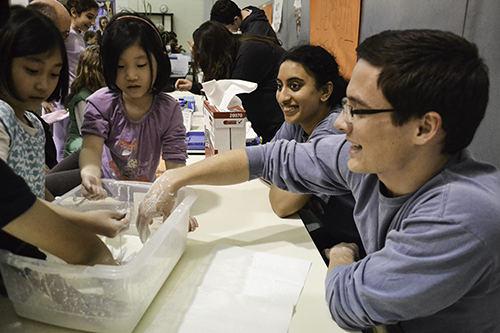
Meha Akella (second from right) and another REACT member (right), introduce young STEM Night visitors to oobleck.
Another Illinois student, Danielle Cooney, a graduate student in Crop Sciences, exposed young STEM Night visitors to a demonstration about erosion. She would pour equal amounts of water into three containers: one was planted with thick grass, one contained a mixture of bark and chips, and was filled with soil only. After water had been poured into the three containers, students were then asked to point out which water was the cleanest (the container with the grass); most could see how a cover crop, like the grass, helped prevent erosion.
Several students from REACT (Reaching and Educating America's Chemists of Tomorrow) an Illinois student outreach group that does Chemistry demonstrations and hands-on activities. Students were able to get their hands on Oobleck (the non-Newtonian slimy substance that acts like a liquid—unless force is applied; then it acts like a solid.
One Illinois student who participated in the event as a part of REACT was Connor McCloskey, a sophomore studying computer science. He says one way events like Barktall’s STEM Night benefits kids is that it “gives them another way to look at things.”
“They always seem to be interested or fascinated, especially with chemistry,” he continues. “The study of change is something that really hooks the kids. And it’s good to just see how creative they are, especially when they are starting to answer questions, and make connections.”
Did McCloskey see some kids that are going to end up in STEM? “Of course I did,” he says. “I saw a bunch of them, especially any of the kids that were involved in all these experiments just seemed to love it.”
Did the principal see any future scientists or engineers during the event? “All of them!” acknowledges Foertsch: “Everybody’s got the potential to be a scientist or engineer.”
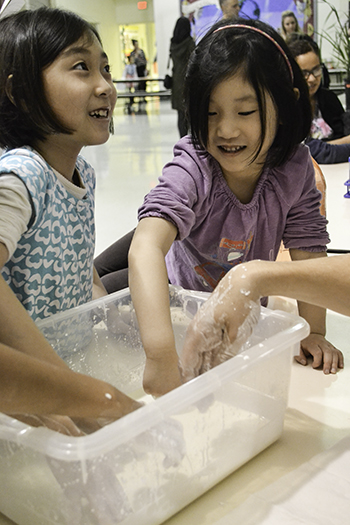
Two students enjoy playing in oobleck.
Meha Akella, a sophomore studying biochemistry at Illinois, who’s also on the REACT board also saw some future scientists.
“Oh, definitely! A lot of them actually knew some of the experiments we were doing. They were like, ‘I know exactly what that is; that’s corn starch in water.’ Or for the Cartesian Divers, ‘Its pressure that does that!’ It was amazing to see them.”
Akella says that events like STEM night are good for youngsters to realize that they can actually do STEM. “Because a lot of kids, especially young girls—I know it was a problem for me—they don’t really get to see how much they know, how good they are at things,” she admits.
She also says that while kids are learning science in schools, activities like the ones they're doing can help get kids more excited in science.
“I know, especially for me in elementary school, a lot of the things we learned were so basic, and it was hard to have a sort of passion and interest for it. And I think this helps show them that there is more to what they’re doing right now; there’s more to learn, and there’s more they can do with science.”
Why pique kids’ interest in science? “I think that’s really important,” she continues. “We always can use more scientists and engineers out there.”
A local mother shares why she brought her daughter to STEM night:
“Because I want her to get even more curious than she already is. And I think exposing her to all these different activities that are fun and are different can get her brain to think further. And I know she can.”
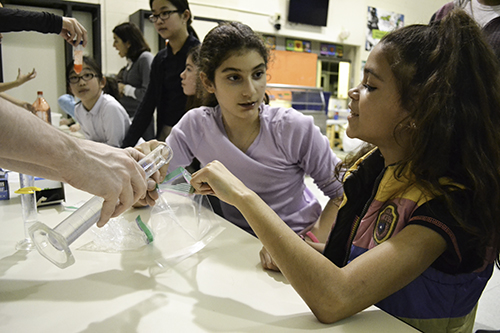
Two Barkstall STEM Night visitors prepare to make silly putty.
She also believes events like STEM night give kids the opportunity to do things they might not have time to do during school.
“I don’t think they are exposed to all these fun experiments during the year at school because there is so much to cover at school that they don’t get to just play and experiment in kind of a fun way—playing, and seeing and comparing—and so this is a great time for them to do that.”
Story and photographs by Elizabeth Innes, Communications Specialist, I-STEM Education Initiative.
For additional I-STEM web articles about Illinois' partnership with Barkstall Elementary, see:
- Physics Van: A Whole Lot of Fun… Plus, You Get to Blow Stuff Up
- REACT: Reaching and Educating Tomorrow's Chemists Today
More: Champaign-Urbana Community, K-12 Outreach, Open House/Expo, Physics, REACT, STEM Pipeline, 2017
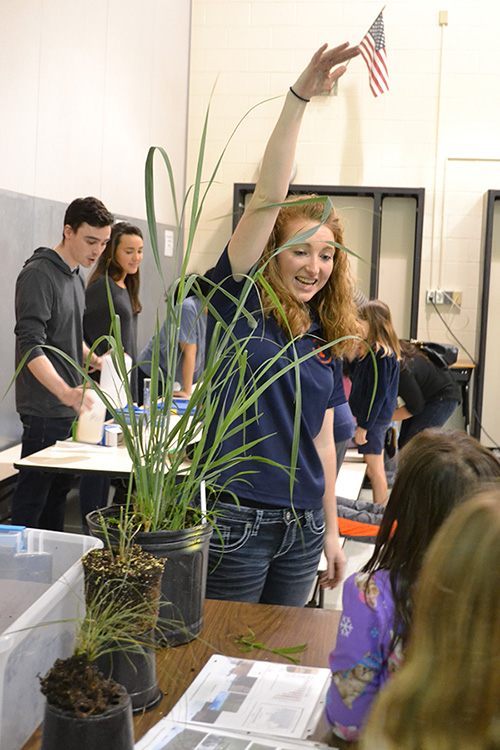
Crop Sciences grad student Danielle Cooney interacts with young visitors, describing how tall the potted grass might grow.
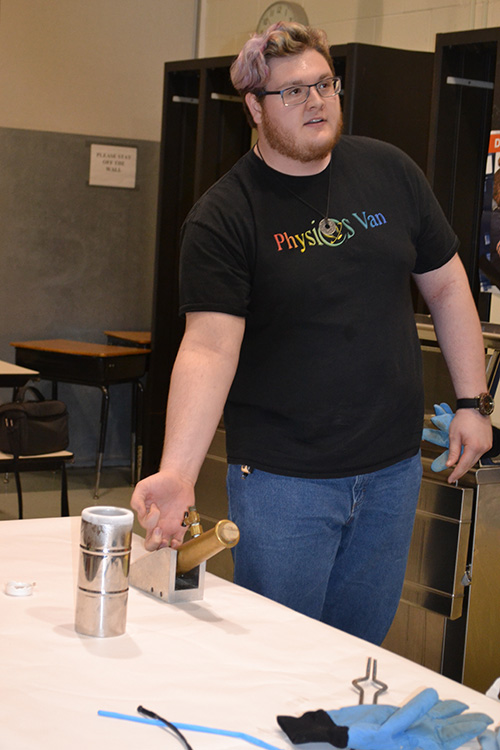
Physics Van member William Helgren prepares to shoot a cork out of the liquid nitrogen cannon.
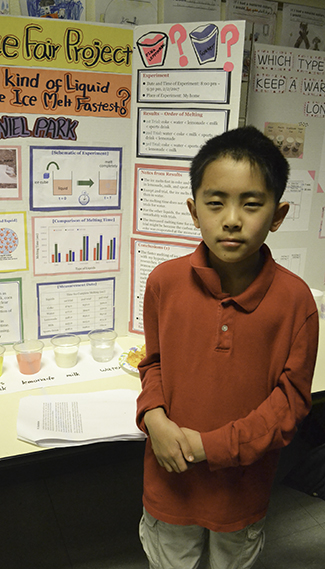
A Barkstall student by the poster he made for his science fair project.

Crop Sciences grad student Danielle Cooney does the erosion demonstration for a mother and her two small children.
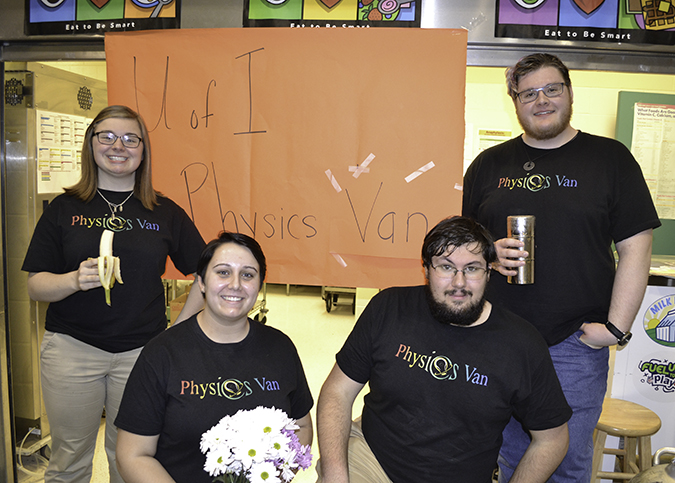
Clockwise: Physics Van members Spencer Hulsey, William Helgren, Shane Cowsert, and Taylor Sabatini.













.jpg)
















